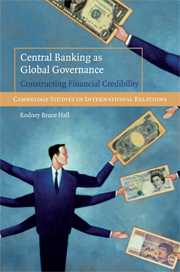Book contents
- Frontmatter
- Contents
- Preface
- 1 Central banking as governance
- 2 The social character of money
- 3 Instituting facts and constituting rules
- 4 Constitutive power relations
- 5 Rules and international monetary systems
- 6 Central bank independence as credibility
- 7 Transparency and intersubjectivity in central banking
- Bibliography
- Index
- Cambridge Studies in International Relations
- References
5 - Rules and international monetary systems
Published online by Cambridge University Press: 03 May 2010
- Frontmatter
- Contents
- Preface
- 1 Central banking as governance
- 2 The social character of money
- 3 Instituting facts and constituting rules
- 4 Constitutive power relations
- 5 Rules and international monetary systems
- 6 Central bank independence as credibility
- 7 Transparency and intersubjectivity in central banking
- Bibliography
- Index
- Cambridge Studies in International Relations
- References
Summary
Monetary economics is a field where an understanding and appreciation of history is arguably more important than a lot of high powered mathematical and statistical analysis.
Michael MussaThe first casualty of war may not be truth but money.
J. K. GalbraithThe international monetary order is a rule-based order. Its history is the history of the construction and demolition of rules: constitutive and regulative, explicit and tacit, substantive and procedural, national and transnational. Thus neoclassical economist Michael Mussa does well to suggest that an examination of the history of monetary economics may offer more insight into the nature of the topic than the more formal, also rule-based, constructed artifice of mathematics. It is rather odd that relatively little attention has been devoted to explication of the history of the international monetary order as rule-based order. This is so particularly as international monetary history is often organized according to a changing periodization of constitutive and regulative rules.
Economic historian Gianni Toniolo, for example, periodizes international monetary history in the late nineteenth to twentieth centuries as characterized by (1) a classical gold standard ending 1914; (2) a system of pegged exchange rates from 1914 to 1924 and again from the mid-1930s to late 1940s, interspersed with (3) a gold exchange standard (attempts to reconstruct gold parities) from 1924 to 1931 to 1936, depending upon accounts of when these attempts were abandoned, followed by (4) the Bretton Woods gold–dollar parity from the late 1940s to early 1970s.
- Type
- Chapter
- Information
- Central Banking as Global GovernanceConstructing Financial Credibility, pp. 114 - 152Publisher: Cambridge University PressPrint publication year: 2008



